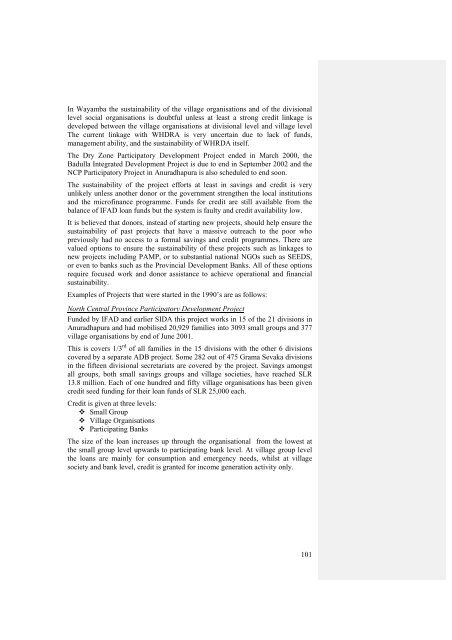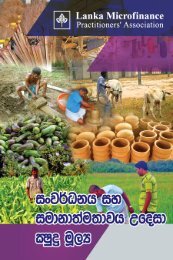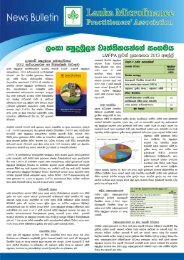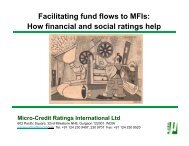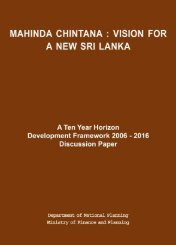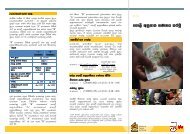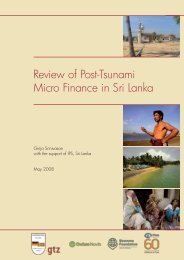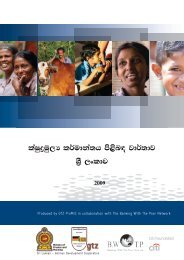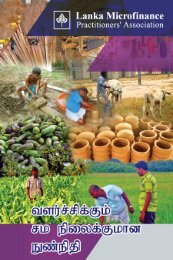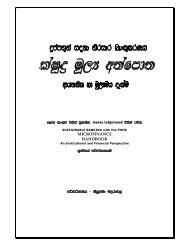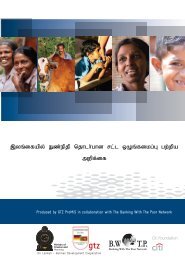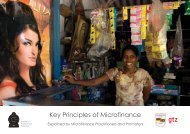National Microfinance Study of Sri Lanka: Survey of Practices and ...
National Microfinance Study of Sri Lanka: Survey of Practices and ...
National Microfinance Study of Sri Lanka: Survey of Practices and ...
You also want an ePaper? Increase the reach of your titles
YUMPU automatically turns print PDFs into web optimized ePapers that Google loves.
In Wayamba the sustainability <strong>of</strong> the village organisations <strong>and</strong> <strong>of</strong> the divisional<br />
level social organisations is doubtful unless at least a strong credit linkage is<br />
developed between the village organisations at divisional level <strong>and</strong> village level<br />
The current linkage with WHDRA is very uncertain due to lack <strong>of</strong> funds,<br />
management ability, <strong>and</strong> the sustainability <strong>of</strong> WHRDA itself.<br />
The Dry Zone Participatory Development Project ended in March 2000, the<br />
Badulla Integrated Development Project is due to end in September 2002 <strong>and</strong> the<br />
NCP Participatory Project in Anuradhapura is also scheduled to end soon.<br />
The sustainability <strong>of</strong> the project efforts at least in savings <strong>and</strong> credit is very<br />
unlikely unless another donor or the government strengthen the local institutions<br />
<strong>and</strong> the micr<strong>of</strong>inance programme. Funds for credit are still available from the<br />
balance <strong>of</strong> IFAD loan funds but the system is faulty <strong>and</strong> credit availability low.<br />
It is believed that donors, instead <strong>of</strong> starting new projects, should help ensure the<br />
sustainability <strong>of</strong> past projects that have a massive outreach to the poor who<br />
previously had no access to a formal savings <strong>and</strong> credit programmes. There are<br />
valued options to ensure the sustainability <strong>of</strong> these projects such as linkages to<br />
new projects including PAMP, or to substantial national NGOs such as SEEDS,<br />
or even to banks such as the Provincial Development Banks. All <strong>of</strong> these options<br />
require focused work <strong>and</strong> donor assistance to achieve operational <strong>and</strong> financial<br />
sustainability.<br />
Examples <strong>of</strong> Projects that were started in the 1990’s are as follows:<br />
North Central Province Participatory Development Project<br />
Funded by IFAD <strong>and</strong> earlier SIDA this project works in 15 <strong>of</strong> the 21 divisions in<br />
Anuradhapura <strong>and</strong> had mobilised 20,929 families into 3093 small groups <strong>and</strong> 377<br />
village organisations by end <strong>of</strong> June 2001.<br />
This is covers 1/3 rd <strong>of</strong> all families in the 15 divisions with the other 6 divisions<br />
covered by a separate ADB project. Some 282 out <strong>of</strong> 475 Grama Sevaka divisions<br />
in the fifteen divisional secretariats are covered by the project. Savings amongst<br />
all groups, both small savings groups <strong>and</strong> village societies, have reached SLR<br />
13.8 million. Each <strong>of</strong> one hundred <strong>and</strong> fifty village organisations has been given<br />
credit seed funding for their loan funds <strong>of</strong> SLR 25,000 each.<br />
Credit is given at three levels:<br />
Small Group<br />
Village Organisations<br />
Participating Banks<br />
The size <strong>of</strong> the loan increases up through the organisational from the lowest at<br />
the small group level upwards to participating bank level. At village group level<br />
the loans are mainly for consumption <strong>and</strong> emergency needs, whilst at village<br />
society <strong>and</strong> bank level, credit is granted for income generation activity only.<br />
101


